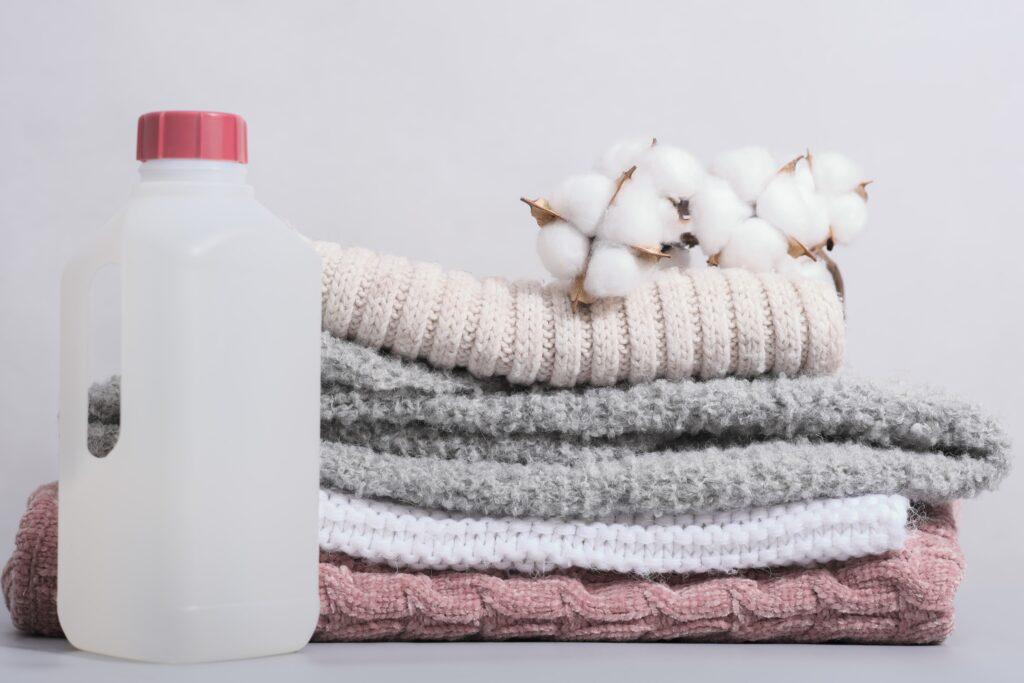Jeans have been a part of our wardrobe for decades, and for good reason. They are versatile, durable, and can be dressed up or down depending on the occasion. However, nothing is more frustrating than putting on a pair of jeans that fit perfectly in the store only to find out they are too tight after a few wears.
in This article, you will learn how to stretch jeans with fabric softener. This effective method will make your tight jeans more comfortable without damaging them.
Fortunately, there is a solution to this problem – stretching your jeans with fabric softener. Fabric softener has long been known for its ability to soften clothes and reduce wrinkles.
But did you know it can also be used to stretch out clothing? This method is popular among denim enthusiasts as it allows them to make tight-fitting jeans more comfortable without damaging the fabric.
The Science Behind Fabric Softener
Before we dive into how to stretch your jeans with fabric softener, let’s first understand what it is and how it works. Fabric softener is a liquid conditioning agent that is added during the final rinse cycle of your laundry. It works by coating the individual fibers of your clothes with a thin layer of chemicals that help reduce static cling, increase flexibility, and improve overall softness.
Most fabric softeners contain three main ingredients: quaternary ammonium compounds (quats), fatty acids or esters, and water. The quats act as surfactants – substances that reduce surface tension between liquids – while the fatty acids or esters provide lubrication between fibers, making them more flexible.
The Benefits of Stretching Jeans with Fabric Softener
Aside from making tight jeans more comfortable, stretching jeans with fabric softener has several other benefits. One advantage is that it reduces wear and tear on the fabric caused by constant pulling and tugging when trying to put on tight-fitting jeans. This can prolong the life of your jeans and save you money in the long run.
Another benefit is that it allows you to keep your favorite pair of jeans even if your weight fluctuates. Instead of having to purchase new clothes every time your body changes, you can simply stretch out your existing wardrobe with fabric softener.
Why Not Just Buy a Bigger Size?
Some may wonder why not just buy a bigger size if their jeans are too tight. While this may seem like a simple solution, it’s not always practical. Not all brands offer a wide range of sizes, and even if they do, finding the perfect fit can be challenging.
Additionally, buying larger sizes can result in ill-fitting clothing that is unflattering and uncomfortable. Stretching jeans with fabric softener provides a customizable solution that allows you to adjust the fit of your clothes as needed without sacrificing style or comfort.
What is Fabric Softener?
When it comes to laundry, fabric softener is a common household item that many people use. It is a liquid or solid product that is added to the final rinse cycle of the washing machine.
The primary purpose of fabric softener is to make clothes soft, comfortable and smell good. Fabric softeners work by coating individual fibers in clothing with a thin layer of chemicals, which helps to lubricate them and reduce static electricity.
This results in clothes that are softer to touch and easier to wear. In addition, fabric softeners can also provide some level of odor control, which can be particularly useful for individuals who sweat excessively.
How Does Fabric Softener Work?
Fabric softeners typically contain three key ingredients: cationic surfactants, silicone derivatives, and fragrances. The cationic surfactants help to neutralize any negative charges on fabrics, making them less likely to cling together or create static electricity during use. The silicone derivatives help to lubricate fibers in the fabric, reducing friction and making them softer.
Fragrances are often added as well – these can come in various scents such as lavender or fresh linen – providing an additional layer of freshness. Typically, fabric softeners are produced with synthetic fragrance blends rather than natural ingredients.
Different Types of Fabric Softeners
There are two main types of fabric softeners available: liquid and dryer sheets. Liquid Fabric Softener: Liquid fabric softener usually comes in a bottle form which you add directly into the washing machine before starting it up.
They offer greater flexibility when it comes to customizing the amount needed for each wash load compared with dryer sheets; however; there have been reports of this type causing skin irritation for some users. Dryer Sheets: Dryer sheets are typically single-use sheets that are placed in the dryer alongside the clothing items.
They work by releasing the fabric softening chemicals onto the clothing as they tumble around during the drying process. They are easy to use and are generally less likely to cause skin irritation; however, they can be more expensive compared with liquid fabric softeners.
In addition to these two main types, there are also natural and eco-friendly alternatives available in the market. These include plant-based fabric softeners which typically contain fewer chemicals and are gentler on clothes and skin.
How to Stretch Jeans with Fabric Softener
Preparing Your Jeans for Stretching
Before you begin stretching your jeans using fabric softener, it’s important to prepare them properly. First, make sure your jeans are clean and dry. Any dirt or moisture on the fabric can interfere with the stretching process.
If your jeans are not clean, take the time to wash and dry them before proceeding. Next, locate any areas of your jeans that are particularly tight or uncomfortable.
This may include the waistband, thighs, or calves. Mark these areas with a piece of chalk so you can monitor how much they stretch during the process.
Mixing Fabric Softener with Water
Once you have prepared your jeans for stretching, it’s time to mix your fabric softener solution. In a large bucket or basin, combine one part liquid fabric softener with three parts warm water.
Stir this solution well until it is fully mixed. It’s important to note that different types of fabric softeners may require different dilution ratios, so be sure to check the label on yours before mixing it with water.
Soaking Your Jeans in the Solution
With your solution mixed and ready to go, it’s time to soak your jeans in it. Submerge your jeans completely in the solution and use a spoon or other tool to ensure they are fully coated.
Allow your jeans to soak in the solution for at least 30 minutes (longer if you want more stretch). Be sure to stir them occasionally during this time so that all parts of each jean receive equal attention.
Drying Your Jeans
After soaking, remove your jeans from the solution and wring out any excess liquid. Hang them up by their waistbands (using hangers) or lay flat on towels until they dry completely.
It’s important to handle your jeans gently during this process so that you don’t accidentally shrink them again. Avoid stretching or pulling on any parts of the fabric, and make sure they are laying flat to dry instead of hanging over a clothesline.
Testing the Fit of Your Stretched Jeans
Once your jeans are completely dry, it’s time to test their fit. Try them on and note any areas that may still be too tight or uncomfortable.
If necessary, repeat the entire stretching process until you achieve the desired level of stretch. It’s also important to note that some fabrics may be more responsive to this method than others.
Denim is a great candidate for fabric softener stretching due to its durability and thickness, but thinner fabrics may not respond as well. Always test on a small area before committing to soaking an entire garment.
Tips for Stretching Jeans with Fabric Softener
Alternative Method: Using a Spray Bottle instead of Soaking
If you don’t have the time or space to soak your jeans in fabric softener solution, you can also opt for a spray bottle. This method is perfect if you only need to stretch certain areas of your jeans, such as the waistband or thighs. Here’s how to do it:
1. Mix your fabric softener solution in a spray bottle. You’ll want to aim for a 1:3 ratio of fabric softener to water.
2. Hang up your jeans on a hanger or lay them flat on a surface that can get wet. 3. Spray the areas that need stretching with the fabric softener solution until they are damp but not soaking wet.
4. Pull and stretch the damp areas gently until they reach your desired fit. 5. Leave them to air dry completely.
Adding Vinegar to the Solution for Extra Stretch
Vinegar is not only an excellent ingredient for cleaning and disinfecting but also an essential item when it comes to stretching clothes, including denim jeans. 1. Add one cup of white vinegar into four cups of hot water, then mix well. 2. Immerse your denim jeans in this mixture and leave it there for about 30 minutes
3.Afterward, remove them from the mixture and wrung out gently excess moisture from the denim trousers. 4.Now stretch out your pants by pulling them down gently
5.Let it air-dry naturally. While vinegar alone may not fully replace fabric softeners’ effectiveness, adding vinegar will help soften fibers further while giving an extra stretch without damaging or wearing out fabrics.
Repeating The Process If Necessary
It’s important not to overstress fibers during this process as overstretching may cause them to lose shape and elasticity. If you didn’t get the desired results from one round, don’t worry — repeat the process until you achieve your objective. It’s generally recommended that users repeat the process no more than twice, as too much use of fabric softener can weaken and damage denim fibers.
However, finding out what works for your own jeans is crucial. By repeating this process with different variations each time, you’ll be able to determine what works best for you.
Try Stretching Your Jeans Early on
If you buy new jeans that are slightly tight from the store or after losing weight but still want them to last a long time and remain comfortable, start stretching them early on before they become too tight. When denim is fresh, it’s more pliable and easier to stretch gently without using much force.
By doing so in advance, there’s little chance of over-stretching or weakening fibers beyond repair. If your jeans are already very tight or hard to wear after several months of wear, try stretching them slowly rather than forcing or yanking them into shape quickly.
Advantages and Disadvantages of Stretching Jeans with Fabric Softener
The Benefits of Making Tight Jeans More Comfortable Without Damaging Them
Using fabric softener to stretch jeans is a great way to make tight jeans more comfortable without damaging the fabric. This is especially useful if you have a pair of expensive or sentimental jeans that you don’t want to get rid of.
The process is relatively simple and doesn’t require any special equipment, making it an affordable option for anyone who wants to stretch their jeans at home. Another benefit of using fabric softener to stretch your jeans is that it’s a gentle method that won’t damage the denim.
Unlike other methods, such as stretching your jeans with weights or heat, fabric softener won’t cause any discoloration or weakening of the fibers. This means you can repeat the process as many times as necessary without worrying about damaging your favorite pair of jeans.
The Drawbacks of Using Fabric Softener to Stretch Jeans
While using fabric softener to stretch jeans has many benefits, there are also some drawbacks to consider. One potential issue is that the method may not work for all types of denim.
Some brands or types of denim may be too stiff or resistant to stretching with fabric softener, so it’s important to test this method on a small area before attempting it on the entire pair. Another potential drawback is that stretching your jeans with fabric softener may not result in a significant change in size or fit.
While this method can help make tight jeans more comfortable, it may not be able to completely transform them into a perfect fit if they are too small or too large. In some cases, you may need to combine this method with other techniques, such as tailoring or alterations, for optimal results.
Conclusion
Stretching your jeans with fabric softener can be a great way to make tight jeans more comfortable without damaging them. While there are some potential drawbacks to consider, such as the fact that this method may not work for all types of denim or result in a significant change in size, overall it is a gentle and affordable way to stretch your jeans at home.
If you have a pair of jeans that are too tight, give this method a try – you may find that it’s just what you need to make your favorite pair of jeans feel like they were made just for you.












